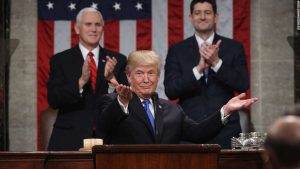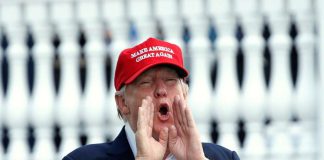SEPTEMBER 16, 2021

WASHINGTON, DC – JANUARY 30, 2018: U.S. President Donald J. Trump delivers the State of the Union address as U.S. Vice President Mike Pence (L) and Speaker of the House U.S. Rep. Paul Ryan (R-WI) (R) look on in the chamber of the U.S. House of Representatives January 30, 2018 in Washington, DC. This is the first State of the Union address given by U.S. President Donald Trump and his second joint-session address to Congress. (Photo by Win McNamee/Getty Images)
Paul Ryan knew that he had a problem. Donald Trump had been elected president and now Ryan, as the Republican Speaker of the House, had to find ways to work with him — despite the two men’s totally opposite approaches to life and politics.
What he did — as documented in the new book “Peril” by authors Bob Woodward and Robert Costa — is both remarkable and revealing.
Here’s the passage:
“Ryan began, on his own, to research how to deal with someone who is amoral and transactional. The exercise initially was difficult. Ryan liked to call himself a ‘policy guy’ but his wonkiness did not extend from the realm of Social Security and Medicare into psychiatry.
“Then a wealthy new York doctor and Republican donor called Ryan and said ‘You need to understand what narcissistic personality disorder is.’ “
The doctor sent Ryan a memo on “how to best deal with a person with anti-social personality disorder” and a variety of links to medical journals on the disorder. Ryan, Woodward and Costa note, “studied them for weeks, convinced that Trump had the personality disorder.” A spokesperson for Ryan didn’t respond to a request for comment.
Ryan eventually decided that dealing with Trump was simply not worth it — shocking the political world by announcing his retirement in early 2018.
This episode is one of a series in “Peril” that suggests that top Republican leaders, even while insisting all was well with Trump on the surface, believed that something could be very wrong with the President.
Obviously, Trump has never been diagnosed with any mental disorder as far as we know publicly.
But Ryan, it’s worth noting here, was far from the only person convinced that Trump suffered from narcissistic personality disorder. In a June 2016 essay for The Atlantic, Northwestern University psychology professor Dan P. McAdams diagnosed (from a distance) the then-candidate similarly, writing in part:
“People with strong narcissistic needs want to love themselves, and they desperately want others to love them too—or at least admire them, see them as brilliant and powerful and beautiful, even just see them, period. The fundamental life goal is to promote the greatness of the self, for all to see.”
And Jennifer Senior, writing in The New York Times in 2019, put it this way:
“A number of Donald Trump’s critics have reached a consensus: We are being governed by a man with a narcissistic personality disorder, almost certainly of the malignant variety, and it’s time to call it by name.”
According to DSM-5, the seminal guide to mental disorders and illness, a person with narcissistic personality disorder demonstrates “a pervasive pattern of grandiosity (in fantasy or behavior), need for admiration, and lack of empathy.”
Trump has pushed back on questions about his mental health and acuity before, calling himself a “very stable genius” and even going as far as insisting that White House physician Dr. Ronny Jackson administer a cognitive exam during his annual physical in 2018. Jackson later told reporters Trump scored exceedingly well.
The debate over what, really, is wrong with Trump — or whether anything is — has long raged, and this book will only fuel that debate. But what’s clear is that people like Ryan, who spent lots of times working closely with Trump, thought that something was seriously wrong. That Ryan — and the rest — said nothing publicly and did nothing to stop him led Trump to grow more and more erratic, culminating with inciting the January 6 riot at the US Capitol.

































































































